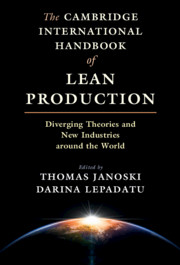 The Cambridge International Handbook of Lean Production
The Cambridge International Handbook of Lean Production Book contents
- The Cambridge International Handbook of Lean Production
- The Cambridge International Handbook of Lean Production
- Copyright page
- Dedication
- Contents
- Tables
- Figures and Sidebars
- Preface
- Acknowledgments
- Contributors
- Abbreviations
- 1 Lean Production as the Dominant Division of Labor
- Part I Theories of Lean Production
- Part II Lean Production across Industries
- Part III Lean Production Around the World
- 17 Lean in Europe and the USA – A New Dominant Division of Labour?
- 18 The Development and Diffusion of the Hyundai Production System
- 19 Transferring Lean to the United States
- 20 Disseminating Lean across the UK: A Personal Reflection
- 21 Lean Production in Germany
- 22 Tricolore
- 23 Lean Production in China: A Case Study of the Automobile Industry
- 24 Lean Production in India and Australia
- 25 The Four Stages of Lean in Mexico
- 26 Lean Production in Post-Communist Europe
- Name Index
- Subject Index
- References
21 - Lean Production in Germany
A Contested Model
from Part III - Lean Production Around the World
Published online by Cambridge University Press: 11 March 2021
- The Cambridge International Handbook of Lean Production
- The Cambridge International Handbook of Lean Production
- Copyright page
- Dedication
- Contents
- Tables
- Figures and Sidebars
- Preface
- Acknowledgments
- Contributors
- Abbreviations
- 1 Lean Production as the Dominant Division of Labor
- Part I Theories of Lean Production
- Part II Lean Production across Industries
- Part III Lean Production Around the World
- 17 Lean in Europe and the USA – A New Dominant Division of Labour?
- 18 The Development and Diffusion of the Hyundai Production System
- 19 Transferring Lean to the United States
- 20 Disseminating Lean across the UK: A Personal Reflection
- 21 Lean Production in Germany
- 22 Tricolore
- 23 Lean Production in China: A Case Study of the Automobile Industry
- 24 Lean Production in India and Australia
- 25 The Four Stages of Lean in Mexico
- 26 Lean Production in Post-Communist Europe
- Name Index
- Subject Index
- References
Summary
The first publications on lean production and the evidence of the competitive advantage Japanese companies held over German competitors (Womack et al. 1990) shocked the German automotive industry of the late 1980s and early 1990s, leading to difficult discussions within companies, trade unions and the academic community about the future development of production systems. While some of the actors pushed for radical change and the adoption of lean production, others pointed out specific conditions in Germany that made directly adopting Japanese models impossible (Turner/Auer 1994; Streeck 1996). The watchword of these latter contributions was “Japan kapieren, nicht kopieren” – understand Japan, but do not copy it.
- Type
- Chapter
- Information
- The Cambridge International Handbook of Lean ProductionDiverging Theories and New Industries around the World, pp. 507 - 528Publisher: Cambridge University PressPrint publication year: 2021


